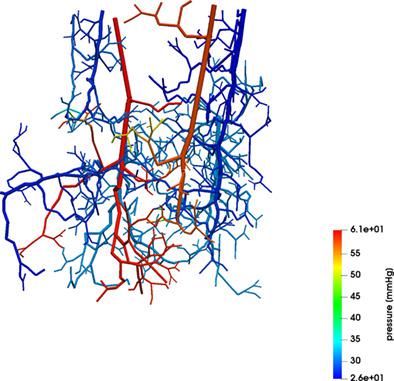当前位置:
X-MOL 学术
›
Int. J. Numer. Method. Biomed. Eng.
›
论文详情
Our official English website, www.x-mol.net, welcomes your
feedback! (Note: you will need to create a separate account there.)
A 3D-1D coupled blood flow and oxygen transport model to generate microvascular networks.
International Journal for Numerical Methods in Biomedical Engineering ( IF 2.2 ) Pub Date : 2020-07-13 , DOI: 10.1002/cnm.3386 Tobias Köppl 1 , Ettore Vidotto 1 , Barbara Wohlmuth 1, 2
International Journal for Numerical Methods in Biomedical Engineering ( IF 2.2 ) Pub Date : 2020-07-13 , DOI: 10.1002/cnm.3386 Tobias Köppl 1 , Ettore Vidotto 1 , Barbara Wohlmuth 1, 2
Affiliation

|
In this work, we introduce an algorithmic approach to generate microvascular networks starting from larger vessels that can be reconstructed without noticeable segmentation errors. Contrary to larger vessels, the reconstruction of fine‐scale components of microvascular networks shows significant segmentation errors, and an accurate mapping is time and cost intense. Thus there is a need for fast and reliable reconstruction algorithms yielding surrogate networks having similar stochastic properties as the original ones. The microvascular networks are constructed in a marching way by adding vessels to the outlets of the vascular tree from the previous step. To optimise the structure of the vascular trees, we use Murray's law to determine the radii of the vessels and bifurcation angles. In each step, we compute the local gradient of the partial pressure of oxygen and adapt the orientation of the new vessels to this gradient. At the same time, we use the partial pressure of oxygen to check whether the considered tissue block is supplied sufficiently with oxygen. Computing the partial pressure of oxygen, we use a 3D‐1D coupled model for blood flow and oxygen transport. To decrease the complexity of a fully coupled 3D model, we reduce the blood vessel network to a 1D graph structure and use a bi‐directional coupling with the tissue which is described by a 3D homogeneous porous medium. The resulting surrogate networks are analysed with respect to morphological and physiological aspects.
中文翻译:

用于生成微血管网络的 3D-1D 耦合血流和氧气传输模型。
在这项工作中,我们引入了一种算法方法来从较大的血管开始生成微血管网络,这些血管可以在没有明显分割错误的情况下重建。与较大的血管相反,微血管网络的精细成分的重建显示出显着的分割错误,并且准确的映射需要时间和成本。因此,需要快速可靠的重建算法来产生具有与原始网络相似的随机特性的代理网络。微血管网络是通过将血管添加到上一步中血管树的出口来构建的。为了优化血管树的结构,我们使用默里定律来确定血管的半径和分叉角。每一步,我们计算氧气分压的局部梯度,并使新血管的方向适应这个梯度。同时,我们使用氧分压来检查所考虑的组织块是否供氧充足。计算氧分压时,我们使用 3D-1D 耦合模型进行血流和氧运输。为了降低完全耦合的 3D 模型的复杂性,我们将血管网络简化为一维图形结构,并使用与 3D 均质多孔介质描述的组织的双向耦合。由此产生的代理网络在形态和生理方面进行分析。我们使用氧分压来检查所考虑的组织块是否供应充足的氧气。计算氧分压时,我们使用 3D-1D 耦合模型进行血流和氧运输。为了降低完全耦合的 3D 模型的复杂性,我们将血管网络简化为一维图形结构,并使用与 3D 均质多孔介质描述的组织的双向耦合。由此产生的代理网络在形态和生理方面进行分析。我们使用氧分压来检查所考虑的组织块是否供应充足的氧气。计算氧分压时,我们使用 3D-1D 耦合模型进行血流和氧运输。为了降低完全耦合的 3D 模型的复杂性,我们将血管网络简化为一维图形结构,并使用与 3D 均质多孔介质描述的组织的双向耦合。由此产生的代理网络在形态和生理方面进行分析。我们将血管网络简化为一维图形结构,并使用与组织的双向耦合,该组织由 3D 均质多孔介质描述。由此产生的代理网络在形态和生理方面进行分析。我们将血管网络简化为一维图形结构,并使用与组织的双向耦合,该组织由 3D 均质多孔介质描述。由此产生的代理网络在形态和生理方面进行分析。
更新日期:2020-07-13
中文翻译:

用于生成微血管网络的 3D-1D 耦合血流和氧气传输模型。
在这项工作中,我们引入了一种算法方法来从较大的血管开始生成微血管网络,这些血管可以在没有明显分割错误的情况下重建。与较大的血管相反,微血管网络的精细成分的重建显示出显着的分割错误,并且准确的映射需要时间和成本。因此,需要快速可靠的重建算法来产生具有与原始网络相似的随机特性的代理网络。微血管网络是通过将血管添加到上一步中血管树的出口来构建的。为了优化血管树的结构,我们使用默里定律来确定血管的半径和分叉角。每一步,我们计算氧气分压的局部梯度,并使新血管的方向适应这个梯度。同时,我们使用氧分压来检查所考虑的组织块是否供氧充足。计算氧分压时,我们使用 3D-1D 耦合模型进行血流和氧运输。为了降低完全耦合的 3D 模型的复杂性,我们将血管网络简化为一维图形结构,并使用与 3D 均质多孔介质描述的组织的双向耦合。由此产生的代理网络在形态和生理方面进行分析。我们使用氧分压来检查所考虑的组织块是否供应充足的氧气。计算氧分压时,我们使用 3D-1D 耦合模型进行血流和氧运输。为了降低完全耦合的 3D 模型的复杂性,我们将血管网络简化为一维图形结构,并使用与 3D 均质多孔介质描述的组织的双向耦合。由此产生的代理网络在形态和生理方面进行分析。我们使用氧分压来检查所考虑的组织块是否供应充足的氧气。计算氧分压时,我们使用 3D-1D 耦合模型进行血流和氧运输。为了降低完全耦合的 3D 模型的复杂性,我们将血管网络简化为一维图形结构,并使用与 3D 均质多孔介质描述的组织的双向耦合。由此产生的代理网络在形态和生理方面进行分析。我们将血管网络简化为一维图形结构,并使用与组织的双向耦合,该组织由 3D 均质多孔介质描述。由此产生的代理网络在形态和生理方面进行分析。我们将血管网络简化为一维图形结构,并使用与组织的双向耦合,该组织由 3D 均质多孔介质描述。由此产生的代理网络在形态和生理方面进行分析。











































 京公网安备 11010802027423号
京公网安备 11010802027423号